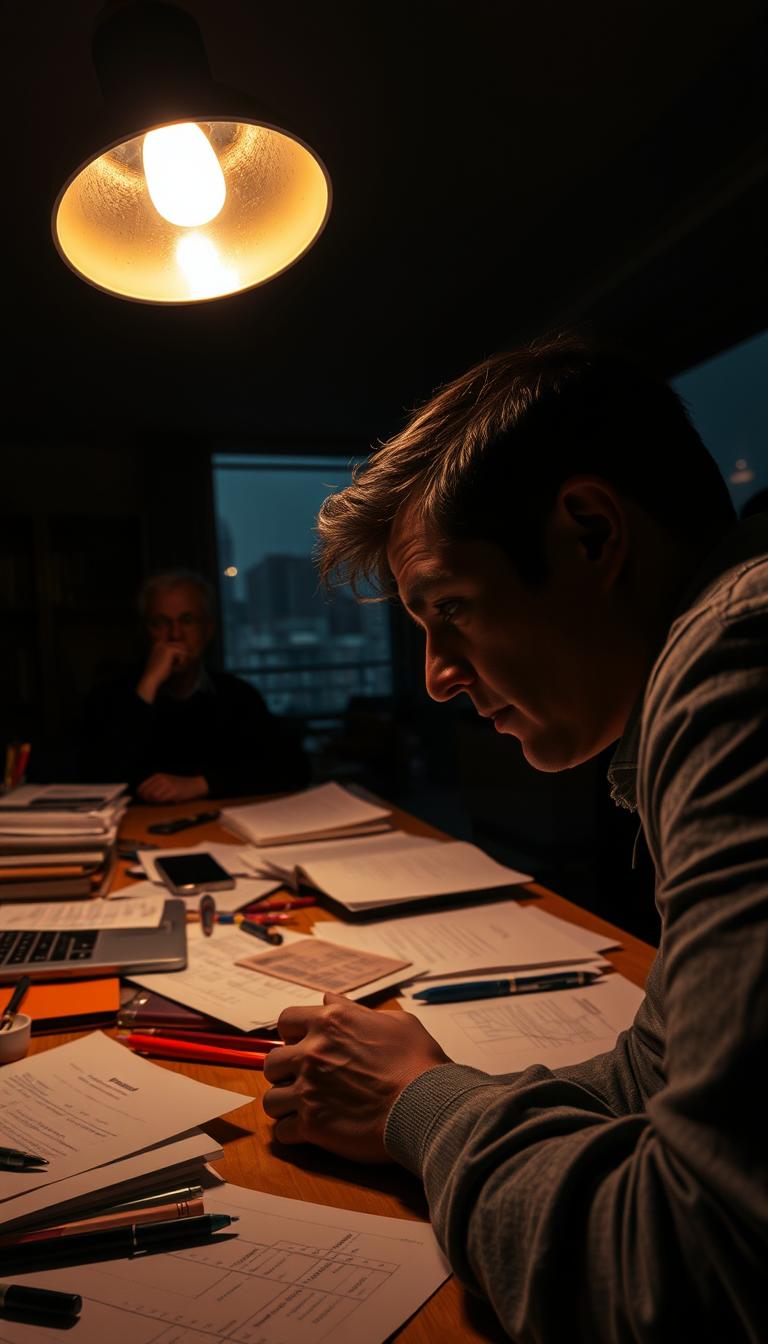Decision Making: How to Avoid Mistakes in 3 Steps
Table of Contents
Effective decision making is key in our lives. It can lead to success or failure. Having a good method is essential.
I found that avoiding mistakes in decision-making is simple. I will share a three-step method to help you make better choices.

Breaking down the process into steps helps avoid errors. It boosts your chances of success. Let’s learn how to make informed choices and improve your decision-making skills.
Why Most People Make Poor Decisions
Poor decision-making is a big problem in our lives. It affects our money, jobs, and relationships. Bad choices can have big consequences.
Common Decision-Making Pitfalls
There are several reasons why we make bad choices. These include:
- Cognitive biases: Our own thoughts can lead us astray.
- Lack of information: Deciding without all the facts.
- Emotional decision-making: Letting feelings guide our choices.
These mistakes can make it hard to solve problems well.
The Cost of Bad Decisions in Daily Life
Poor choices can cost us a lot. A bad investment can lose us money. A wrong job choice can make us unhappy and limit our career.
Some common costs are:
- Financial losses from bad investments.
- Strained relationships from quick decisions.
- Missed chances because of fear or doubt.

Knowing these pitfalls and their effects is the first step to better decision-making.
The Science of Decision Making
The science of decision making shows how our brains make choices. Knowing this can help us make better decisions.
How Your Brain Processes Choices
Our brains weigh options against what we know and have experienced. This process involves different brain parts, like those for rationality and emotions.
The prefrontal cortex is key in judging risks and benefits. The amygdala handles our emotional reactions. How these parts work together affects our choices.

Emotional vs. Rational Thinking
Decisions come from both emotions and rational thinking. Rational thinking looks at facts, while emotional thinking uses our values and past.
When Emotions Help vs. Hinder
Emotions can help or hurt our decision-making. They can offer quick insights but also lead to cognitive bias, clouding our judgment.
| Aspect | Rational Thinking | Emotional Thinking |
|---|---|---|
| Decision Basis | Facts and Figures | Values and Experiences |
| Speed | Generally Slower | Can be Quicker |
| Potential Bias | Less Prone to Bias | More Prone to Cognitive Bias |
Understanding how our brains make choices and the role of emotions and rationality helps us make better decisions.
Understanding Cognitive Biases That Cloud Judgment
It’s key to know the cognitive biases that cloud our judgment. These biases affect our choices in both our personal and work lives. They are patterns of thinking that don’t follow rational judgment, often leading to bad decisions.
Confirmation Bias: Seeing What You Want to See
Confirmation bias makes us look for and remember information that supports what we already believe. This can lead to poor decision-making by ignoring facts that go against our views. For example, when thinking about investing in a stock, we might only look at good news and ignore the bad.
Overconfidence Bias: Why We Think We Know Better
Overconfidence bias happens when we think we know more than we do. This can lead to taking too many risks without doing a proper risk assessment. For instance, an investor might think they can always pick winning stocks, leading to big financial losses.
Recency Bias: Giving Too Much Weight to Recent Events
Recency bias makes us focus too much on recent events, ignoring the past. This can make us think recent trends will keep going forever. In decision-making, it can cause us to make reactive decisions based on what’s happening now, not long-term plans. Using critical thinking helps balance our view by considering both recent and past information.
To make better choices, we need to know about these biases and fight them. By doing this, we can make our decision-making better, leading to more informed and rational choices.
- Be aware of your biases to make more informed decisions.
- Practice critical thinking to evaluate information more effectively.
- Conduct thorough risk assessments to avoid unnecessary risks.
My 3-Step Method for Effective Decision Making
I’ve developed a simple, three-step method for making decisions. It works well in both personal and professional life. This method is easy to follow and can be used for many types of decisions.
Overview of the Method
My decision-making process has three key steps. First, you clarify what you need to decide. Then, you gather and analyze information. Lastly, you choose the best option. This method ensures you consider everything important and make a smart choice.
When to Apply This Approach
This method is great for many types of decisions. It helps with personal problems, business challenges, or investment choices. It’s very helpful when the situation is serious or when you’re not sure what to do.
Tools You’ll Need
To use this method, you’ll need a few basic tools. You need to know your goals and what you can’t do. You also need information and a way to compare your options. Useful tools include decision matrices, lists of pros and cons, and risk assessment templates.
- A notebook or digital tool for note-taking and organization
- A decision matrix template for evaluating options
- A list of key criteria to guide your decision making
By using these tools and following the three-step method, you can make better, more confident decisions. These decisions will match your goals and values.
Step 1: Clarify Your Decision Parameters
Good decision making starts with knowing what guides your choice. When deciding, it’s easy to miss key points. By clarifying your decision parameters, you make better choices.
Defining the Actual Problem
The first step is to clearly state the problem you’re trying to solve. We often jump into solving what we think is the problem, only to find out we were wrong. Take time to clearly define the problem. Ask yourself, “What are the symptoms?” and “What are the consequences if not solved?”
Identifying Your Goals and Constraints
After defining the problem, identify your goals and constraints. What do you want to achieve? Are there any limits that could affect your choices? Knowing your goals keeps you focused. Recognizing constraints helps avoid unrealistic options. This step is key in solving problems.
Setting Clear Decision Criteria
With your goals and constraints in mind, set clear decision criteria. This means deciding what factors will influence your choice. For example, when buying something, consider cost, quality, and brand. Having criteria helps make a rational choice.
Creating a Decision Framework
To use your criteria, create a decision framework. This can be a table or list that outlines your criteria and their importance. For example, you might have a table with “Criteria,” “Weight,” and “Score” columns. This helps you evaluate options systematically.
By following these steps, you clarify your decision parameters. This sets you up for success in making decisions. Remember, the better your preparation, the better your decision. By defining the problem, identifying goals and constraints, and setting criteria, you’ll make a choice you can trust.
Step 2: Gather and Analyze Information
The second step in my decision-making method is to collect and evaluate data. This step is key to making informed decisions.
Effective Research Techniques
To get the right information, using good research techniques is important. This means looking at credible sources, doing surveys or interviews, and using the internet wisely. Reliable information is the backbone of any sound decision.
For example, when thinking about a big purchase, reading reviews and comparing features is smart. Asking friends or experts for advice is also helpful. The goal is to stay objective and not let first impressions cloud your judgment.
Critical Thinking in Information Assessment
After gathering info, it’s important to think critically about it. This means checking if sources are trustworthy, spotting biases, and understanding the context. Critical thinking helps in distinguishing between relevant and irrelevant data.
A critical thinker questions assumptions, analyzes arguments, and looks at different viewpoints before making a conclusion.
Avoiding Information Overload
In today’s world, there’s a lot of information out there. To not get overwhelmed, it’s good to have clear criteria for what’s important. Also, prioritize sources based on their credibility and relevance.
Separating Facts from Opinions
It’s also key to know the difference between facts and opinions. Facts are things you can prove true or false, while opinions are personal views. Separating these ensures that decisions are based on factual information and not just personal feelings.
To show why gathering and analyzing information is important, let’s look at a simple example:
| Criteria | Informed Decision | Uninformed Decision |
|---|---|---|
| Research | Thorough research conducted | Little to no research |
| Information Sources | Multiple credible sources | Limited or biased sources |
| Outcome | More likely to achieve desired outcome | Higher risk of undesirable outcome |
By following these steps and being careful with the information we gather and analyze, we can make better decisions. This improves our judgement and rationality.
Step 3: Evaluate Options and Assess Risk
We’ve got our decision criteria clear and all the info we need. Now, it’s time to look at our choices and figure out the risks. This step is key to making a choice that fits our goals and limits.
Creating a Decision Matrix
A decision matrix is a great tool for comparing options. You list your choices as rows and criteria as columns. Then, score each option against each criterion. This makes it easy to see which option is best.
For example, picking a new car? Your criteria might be price, fuel efficiency, safety, and brand. Scoring each car against these points helps you choose the right one.
| Car Model | Price | Fuel Efficiency | Safety Features | Brand Reputation | Total Score |
|---|---|---|---|---|---|
| Model A | 8 | 7 | 9 | 8 | 32 |
| Model B | 7 | 8 | 8 | 7 | 30 |
| Model C | 9 | 9 | 7 | 9 | 34 |
Risk Assessment Strategies
Looking at risks means spotting downsides and figuring out their chance and effect. A good way is to list risks for each option and judge their chance and effect. This shows which risks you can handle and which you can’t.
Risk Assessment Techniques:
- Identify possible risks
- Check the chance and effect of each risk
- Plan how to deal with big risks
Making the Final Choice
After looking at options and risks, it’s time to decide. Compare your decision matrix and risk assessment. The best choice is the one that matches your criteria and has manageable risks.
Knowing When to Trust Your Gut
Even with good analysis, you might feel unsure. That’s when to listen to your gut. Data is important, but sometimes your intuition is too. It’s about mixing analysis with instinct.
“The key is not to prioritize what’s on your calendar, but to bring your calendar in alignment with your priorities.”
Real-Life Examples of My Method in Action
My three-step method helps people make better choices in their lives and work. It has been tested in many situations, like changing careers or making big investments. Every time, it has led to positive results.
Personal Decisions: Career Changes and Major Purchases
Thinking carefully is key when you’re thinking about a new job. For example, I once had to choose between a job with more pay but a long commute. Using my method, I weighed the pros and cons and made a smart choice.
When buying something big, like a house, my method is also helpful. It helps you see the risks and benefits. You define the problem, gather info, and then choose the best option.
Business Decisions: Investment and Strategy
In business, making good choices is all about analysis. My method helps with investment decisions by looking at key factors, gathering data, and checking risks. This way, businesses can make choices that help them grow.
For example, when thinking about investing in new tech, my method helps. It looks at the return on investment, the competition, and if it fits the company’s goals. This careful analysis helps businesses make smart decisions.
How I Avoided a $50,000 Mistake
My method saved me from a big mistake once. I was about to invest in a project that looked good at first. But, my method showed me the risks I hadn’t seen. Thanks to careful analysis, I avoided losing $50,000.
| Decision Type | Method Applied | Outcome |
|---|---|---|
| Career Change | Critical Thinking, Decision Matrix | Informed Choice |
| Major Purchase | Risk Assessment, Benefit Analysis | Satisfactory Outcome |
| Business Investment | Strategic Analysis, Risk Evaluation | Avoided $50,000 Loss |
Conclusion: Becoming a More Effective Decision Maker
Learning to make good decisions takes time and effort. My three-step method can help you make better choices. It works for both personal and work life.
To make better decisions, first, know what you need to decide. Then, gather all the information you can. Lastly, weigh your options and think about the risks. This way, you’ll make choices that fit your goals and values.
Using these steps will make you more confident in your decision-making. Good decision-making skills are very important. They can greatly improve your life at work and at home.






